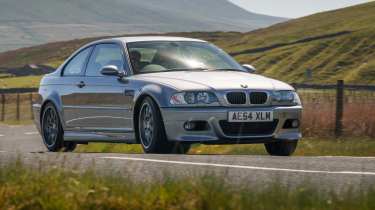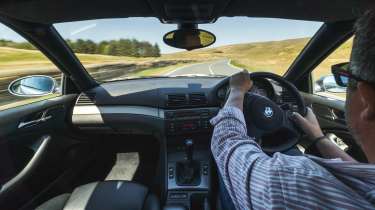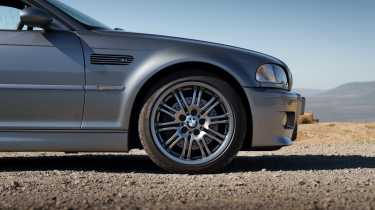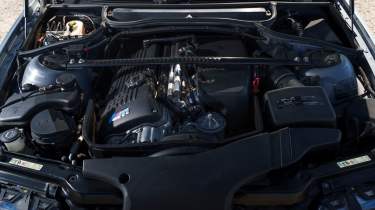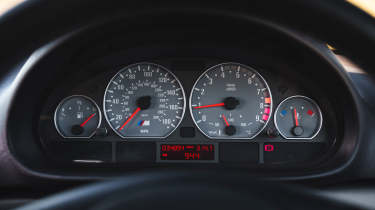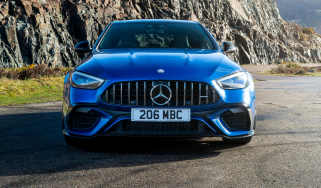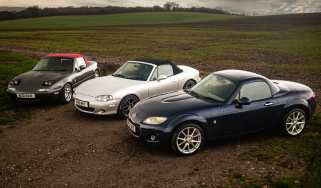Used BMW M3 (E46, 2000 - 2006): an analogue sports coupe icon
The E46 was the first M3 to be launched during evo’s lifetime, and its unique character ensures it remains one of the very best
The E46 BMW M3 starred on the cover of issue 024, September 2000, along with the line ‘Why this will be the best driver’s car BMW has ever built’. Bold, given the pre-existence of the E30 M3, but BMW had taken the 24-valve straight-six engine from the slightly underwhelming but big-selling E36 M3, tickled it up and built a much more capable, more bespoke car around it. The E46 coupe had aluminium panels, blistered wheelarches and an impressive evolution of the M Power six that revved all the way to 8000rpm and delivered 338bhp to the rear wheels via the first M Differential.
It had also completed an incredible development journey that included an unprecedented 80,000 miles lapping the Nürburgring. ‘In a way, all that circuit time does become a part of the car – gives it a special quality,’ said Klaus Schmidt, leader of the test regime. Back then, ‘Nürburgring fatigue’ hadn’t fully taken hold, but not long after in one of his columns Richard Porter decried the effect of the Nordschleife, stating that ‘it produces cars that ride so badly that after 20 miles on B-roads you emerge three inches shorter’. In fact, just a few miles along these tricky Dales roads in a number of these cars suggests that he may have been talking out of his ring…
More reviews
> BMW M5 (E39, 1998 - 2003): review, history and buying guide
I can’t recall the last time I drove a standard E46 M3, yet plonking myself in the driving seat, it’s as if I’ve never been away. Before I’ve turned the key I can hear the classy drawl and distinct, jangly, metallic overtones of the M Power straight-six, and before I’ve laid a hand on the tall gearlever I can feel the light, knuckly shift action. And, yes, as expected, the steering wheel rim still feels a bit too fat.
But what an incredible engine, so rich in character and energy. Today’s ubiquitous light-pressure turbo engine has come a long way, but getting reacquainted with the ‘S54’, arguably the pinnacle of naturally aspirated in-line BMW sixes, is a bit of a kicker, a reminder of what we’ve lost: cracking throttle response and a sound that is symphonic in breadth and reach as it climbs the rev-range, culminating with a euphoric 8000rpm crescendo.
Another reminder of what we’ve lost is the E46 M3’s handling. It’s a car that’s happy to lope along, especially on the 18s, which give a smoother-edged ride than the optional 19s, the steering fairly light. However, pick up the pace and it snaps into turns keenly and reveals terrific mid-corner poise and composure, no matter how hard you push. This, I think, is the ‘special quality’ that Klaus Schmidt alluded to, and it comes with marvellous malleability thanks to a kerb weight of less than 1500kg and the brilliant M diff, which helps make the car’s handling so intuitive and exploitable. Electronic stability control was just starting to find its way onto cars and the M3 had DSC, but as we said at the time, its handling was so good it didn’t really need it.
Dickie Meaden is a big fan of the BMW. ‘I really love it: the size of the car, the sweetness and sharpness of the engine and that lovely, snickety gearshift. And it has such balance and poise that you feel the car working whilst it’s generating grip and finding traction. Yet while you’re aware of what it’s doing, the car doesn’t feel like it’s working really, really hard.’
The M3 came out on top in tests against ‘proper’ sports cars and did brilliantly at eCoty 2001 too, finishing second only to the Pagani Zonda C12‑S. There did seem to be scope for a more focused model, though. In time the CSL duly arrived, bringing pluses but also some minuses, thus confirming how finely judged the standard car was. Most notable in the minus column (above even the unimproved, trackday-limp brakes) was the SMG gearbox, a manual with an automated single-plate clutch. Downshifts were OK but upshifts were either ponderous or brutal. – John Barker, evo issue 336
Everything can wait when the M3’s ‘S54’ 3.2-litre straight-six is zinging its way towards the 8000rpm cut-out. In fact, it’s a show-stopper even when you don’t wring it out. The noise, the response, the beautifully progressive power curve; it’s all so perfect even when you’re miles away from the theatre of the top-end. It’s so easy to drive modern turbocharged engines and think – genuinely believe – that they ‘sound great’. Or feel special. I’m sure I’ve been guilty more than once of suggesting that these monstrously powerful engines ‘feel almost normally aspirated’. But just a few minutes in this M3 is enough to make a mockery of these sorts of claims.
The S54 simply provides a different level of engagement and excitement, and every time you crack the throttle it’s a reminder that this car is a product of BMW’s Motorsport division. Forget the ravages of old age. For this remarkable engine the passing years have only served to make its scintillating response ever more enthralling. It really does feel pin sharp. Alive, too. Its metallic, shrill soundscape has a range and arc that a new car with particulate filters, that familiar flat, parping exhaust note and pre-programmed pops and bangs can’t hope to match.
Regardless of the greater dynamic picture of the car, that 3.2-litre straight-six is enough to make this M3 a true icon and very much worth your attention, affection and, very possibly, your hard-earned money. Simply put, you can’t buy this sort of hard-edged, highly-tuned, savagely sharp mechanical experience today unless you’re in the market for a 911 GT3 or Ferrari 12 Cilindri. Even then, the M3 does things those cars can’t do. It’s narrower, less overt and has much less mechanical grip, which means you can exploit the engine to the full so much more often.
There’s more to tell, though. Good and bad. The great stuff starts with this car’s intrinsic rightness. As with the engine’s dazzling character, the simple nuts and bolts of the E46 M3 seem more appealing as the years roll by. It looks so lean and simple but retains an inescapable sense of purpose. Very often the aggression of performance cars fades as they age and the models that supersede them grow in musculature and scale, but this Titanium Silver Metallic example – a full-grown adult at 21 years and 77,000 miles – looks quietly aggressive and doesn’t have an ounce of fat on it.
Beneath the skin the appeal is stronger still. The M division worked hard to create a stable, highly responsive platform for the E46 M3. The front suspension featured a wider track with unique lower arms, bearings and stiffer bushings, reinforced with a bracing thrust plate to increase rigidity. There are also new steering knuckles, modified wheel bearings, and the subframe was taken from the 3-series Convertible for added strength. The steering ratio is slightly quicker than normal models at 15.4:1. The changes are similarly thorough at the driven wheels. The rear axle is housed within an uprated subframe with a V-brace to locate it to the main structure, features a wider track, and the upper and lower arms utilise rose joints instead of rubber bushings. That Variable M Differential works by detecting differing wheel speeds, at which point a shear pump develops pressure in a silicon viscous fluid and directs it at a multi-disc clutch to transfer torque to the wheel with the better traction.
The pure joy of the E46 M3 in full flow is still out of reach. The ride is generally nicely controlled but the old vertical bounce (which is much more pronounced on non-CS or CSL models fitted with 19-inch wheels) still rears up at times and can make this lithe-looking car feel a shade heavier than expected. However, the glaring dynamic weak link is the steering. The CSL and CS adopted a faster rack (with a ratio of 14.5:1) and this standard car illustrates why that decision was taken. Despite fantastic underlying agility and accuracy, the size of steering input required to get the M3 into a corner is a surprise and blunts a bit of the sharpness you’d hope to find. Did I mention the brakes are crap?
Yet for all that, the M3 really is a riotously fun car to drive. Although this is quickly turning into a love letter to that straight-six engine, it’s important to understand not only how special the S54 is, but how its power delivery is such a key driver of the car’s dynamics. With no turbochargers in sight, there isn’t a big slug of torque for the rear axle to try to contain. Instead – and this is also thanks to the M Differential – there is fantastic traction, allowing you to adopt a high-energy, highly committed driving style.
Carry speed, chase the throttle, trust in the rear axle and learn to appreciate that when the limits are breached there isn’t the crazy power of a modern M3 to spin up the wheels in a heartbeat. Everything is progressive but fast-paced, corrections are small and accurate and the car isn’t lazily falling into time-sapping oversteer, or making big, scary snaps as vast tyres finally let go. It’s just edging into slip to aid front-end bite, ebbing and flowing with the road and absolutely in tune with throttle and steering inputs. Now all the doubts are gone. The gearbox seems sweeter, the steering response and feel are better once the car is loaded up, and suddenly the E46 M3 moves with an energy and lightness of touch that matches its on-paper promise and its clean, confident aesthetic. It’s quick, too. The engine loves to rev but the M3 makes seriously good progress even if you rarely venture beyond 5000rpm.
The fast A-roads and narrow lanes of Salisbury Plain are not the Route Napoléon. Yet the M3 does a pretty good job of transforming them into an immersive, fascinating challenge. Partly, it’s the work rate. The way it encourages you to seek out every last rev and confidently work through the gears; the dawning realisation that you can always get on the throttle earlier than you think, and how attentive you need to be in order to really make the car flow. It’s a challenge – to finesse each shift without losing momentum and use the car’s stunning balance to your advantage by simply hurling it at corners, giving the front a split-second to bite and then loading up that effective rear differential as quickly as possible. And it’s also so simple. The only nod to the future trend of driving modes is a Sport button, which makes the throttle an on/off switch and is best avoided. Life with an M3 is easy: jump in, let the engine warm through and then wring its neck.
So, it’s good. Really, really good. If you can get a CS with the faster steering rack and more settled suspension then it’s even better, but the E46 M3 delivers even in its original incarnation. Plus, a bit of snooping around suggests fitting the faster rack is a cheap and well-trodden upgrade path. And that’s what is really great about this M3. It’s a solid-gold icon and a fabulous driver’s car; it looks sensational, is mostly reliable and is served by lots of highly respected specialists, and yet it’s still within the grasp of a great many people. Which means if you bought one it wouldn’t feel like some sort of sacrilege to carefully upgrade certain components to further sharpen the experience.
Too often we lament the passing of evo icons from the hands of enthusiasts to collectors. The E46 M3 is still out there, within reach and ready to be driven and enjoyed. I fear it can’t stay that way for long… – Jethro Bovingdon, evo issue 322
Buying guide
Whilst the CS and CSL have appreciated rapidly in recent years, there are still plenty of E46 M3s out there at reasonable money. So many of the models that represent the ‘last analogue heroes’ are out of reach now, but for less than £20,000 you could conceivably land yourself one of the very best. In a market where people will happily pay £50,000 over an already eye-watering list price to have the latest and greatest, it’s nice to think you could have one of the all-time greats for under £20,000.
Arriving in 2001, the E46 M3's 3.2-litre straight-six featuring an evolution of the 330Ci’s Double Vanos variable valve timing, while a lightweight crankshaft and graphite-coated aluminium pistons allowed it to spin at 8000rpm. In 2003, the £58K CSL brought 355bhp, a carbonfibre roof, cut-slick tyres and a price tag £20K over the basic car. The halfway-house CS of 2005 was an evo favourite.
The past two decades have been kind to the engine, and with the latest two M3s receiving a turbocharger and even the earlier E92 generation swapping six- for eight-cylinders, the E46 possesses a classic charm that’s been lacking from the M3 badge ever since.
Even in 2025, it’s a peach of a powertrain. It produces a useful 269lb ft of torque from 5000rpm – a high number by today’s turbocharged standards – proving that the engine needs to be revved to offer its sweetest performance, and sounds just plain old lovely. We described the note as a ‘confident howl that pushes all the right buttons’ back in evo 025.
Sadly, the M3 isn’t completely bullet proof. Ex-evo editor and general motoring expert Peter Tomalin confirms: ‘pre-June ’03 engines were prone to crankshaft big-end bearing failure; oil supply upgrades should have been sorted under warranty.’ If there’s no history to prove they have, be very wary.
Good servicing is crucial, including the run-in service at 1200 miles – the cheaper the car, the more likely that corners have been cut. Cracking subframes are another well-known problem, but thankfully easily fixable if caught early enough. If left to develop however, an expensive repair job could be on its way. We advise on listening out for tell-tale clicks when accelerating and braking on test-drives.
Other, less crucial suspension related issues are also fairly common amongst higher-mileage cars these days, but in general, the E46 M3 is a strong runner. There’s no reason why a high-miler couldn’t still be driven hard, just as long as it’s seen regular servicing and is allowed to warm up fully.
What to pay*
Earlier convertible models are the cheapest of the range, with prices rising significantly for low-mile coupes and highly sought after CS and CSL models. *Prices as of September 2025
| BMW M3 (E46) | BMW M3 CS (E46) | BMW M3 CSL (E46) | |
| Excellent | £35,000 | £50,000 | £125,000 |
| Good | £25,000 | £40,000 | £95,000 |
| Average | £18,000 | NA | £70,000 |
| Project | £9000 | NA | NA |
BMW M3 (E46) specs
| Engine | Straight-six, 3246cc |
| Power | 338bhp @ 7900rpm |
| Torque | 269lb ft @ 5000rpm |
| Weight (kerb) | 1495kg |
| Power-to-weight | 230bhp/ton |
| 0-60mph | 5.1sec |
| Top speed | 155mph (limited) |
| Price when new | £39,730 (2004) |
| Price today | £9000 - £125,000 |
This story was first featured in evo issue 322 and 336.
